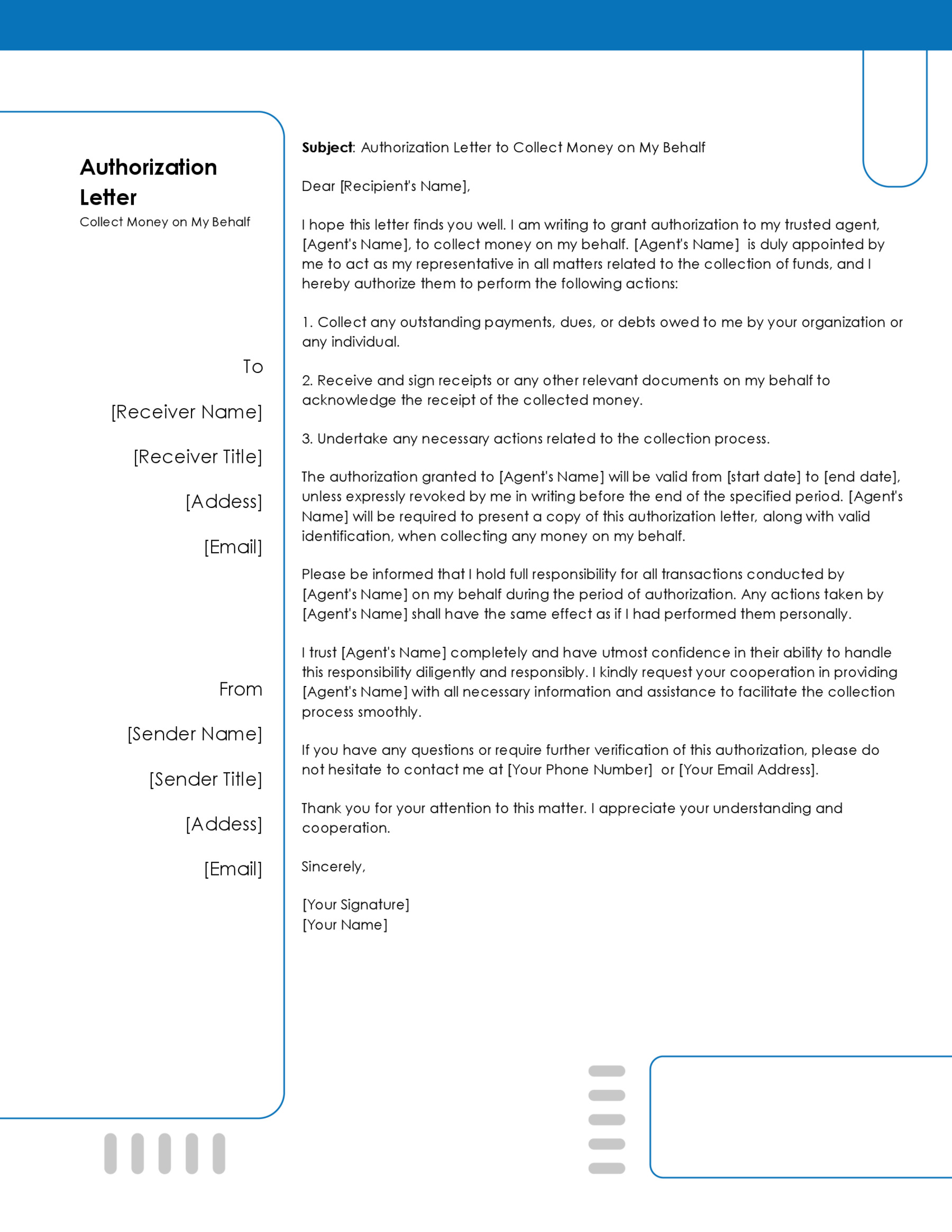Nonprofit organizations require funding to carry out their projects or programs. These funds are often acquired from donors or partners; however, they may not be enough to enable them to implement the projects. Applying for grants is an effective way for a nonprofit to obtain funding. Other than their application or proposal for the grant, nonprofit organizations can obtain a letter of support to try and increase their chances of being selected. The support letter writer must clearly understand what it is, its purpose, and how it should be written.
This article will help take you through everything you need to know about support letters.
What is It?
A letter of support is a document written by a third party to explain why a nonprofit organization deserves to receive funding for its programs and services.
It is written to boost the nonprofit’s application or proposal for a grant. In addition, the third-party organization or business writing the support letter is required to demonstrate that the nonprofit can successfully deliver on its promises and accomplish its mission.
Who Can Write it?
A letter of support should be written by an individual, business, or organization outside the nonprofit organization. It helps show that an outside party believes in the nonprofit organization’s ability to achieve its goals.
EXAMPLE
A partner to the organization, a significant funder/donor, a local business owner, a key stakeholder, a congress representative, or other foundation can write it.
It can also be written by a community leader that believes in the organization or people receiving services from the nonprofit.
It can also fall under two categories. The first is according to the partners’ knowledge who provide monetary aid to programs run by the nonprofit. The second is according to people who support the program idea.
Support letters that fall into the second category will be dependent on where the letter is sourced from:
- A letter of support from a collaborative partner helps show that the program will benefit the community it hopes to serve.
- A letter from a contribution supporter helps show that the program will receive tangible resources that can be deducted from the grant they are requesting.
- A letter from community leaders helps establish the proposal’s credibility while
- A letter from impacted constituents helps demonstrate the repercussions of the program’s implementation.
Purpose
The primary purpose of a letter of support is to persuade a funder into providing the nonprofit with the grant. It is also aimed at showing the credibility and commitment of the nonprofit organization by demonstrating that it has established a good reputation with an outside party. It also shows that the nonprofit genuinely plans to collaborate with other interested partners to ensure the program’s success.
Finally, it helps back up the nonprofit’s qualifications and ability to implement the proposal successfully with the grant’s help.
Letter of Support Vs. Memorandum of Agreement
A letter of support and a memorandum of agreement may accompany the nonprofit’s proposal or application. However, they also have distinct differences based on the fact that they both serve different purposes. The significant difference is that a letter of support expresses support for an idea by the nonprofit. Its messaging is aimed at appealing to a potential guarantor.
On the other hand, a memorandum of agreement outlines tangible support that the writer is willing to provide to the nonprofit as a show of support, such as goods, services, or funding. Its messaging aims to appeal to potential guarantors and organizations that may be willing to partner with the nonprofit. The letter of support writer may or may not opt to use it as a memorandum of agreement; however, a memorandum of agreement is always considered a letter of support.
Pre-Considerations
Before the letter can be written, there are a few considerations the writer should consider. These considerations will help make the writing process easy. They will also guide the writer on what to include in the support letter.
These considerations include the following:
Review the application’s guidelines
The writer should review the application’s guidelines to obtain adequate information about the grant the nonprofit is applying for. The nonprofit should also provide the organization with essential facts, statistics, and plans to ensure they are included in the letter of support. It enhances the writer’s credibility by showing that research on key details was conducted.
Create a list of key points
The writer should use the information obtained to identify and create a clear list of key points highlighted in the letter of support. The points can be backed up using statistics, facts, and anecdotes. The use of appropriate storytelling methods can also help keep the reader engaged in the presented points.
Develop an outline
Using the list created, the writer should develop an outline to ensure all the elements that demonstrate support for the nonprofit’s proposal are included in the letter. The most vital points should be indicated first as they are more impactful. Then, related points should be highlighted in the same paragraph to make it coherent.
Write a rough draft
Finally, a rough draft of the letter of support should be created using the outline. It acts as a guide on how the support letter will be written. The rough draft should incorporate phrases and keywords highlighted in the outline. Links between the supporting elements and key phrases should be created to help ensure that the guarantor understands how these details are related.
What to Include?
The writer of the letter of support should clearly understand the elements that should be included. These elements will help make the letter compelling. They will also enable the writer to convey the message of support clearly and effectively.
The elements should include the following:
The writer should begin with a header indicated at the top of the letter. The header should contain the date, name, and contact information of the recipient. In addition, a salutation that begins with ‘Dear’ should be indicated. The writer should also address the recipient appropriately by their last name using Mr., Mrs., Ms., or Dr.
Introduction
Next, the writer should write a compelling introduction. The introduction will help hook the recipient. It should contain the following information:
Introduce who you are and for whom you are writing
The writer should begin with a self-introduction. The self-introduction should outline the writer’s name and the company or organization they work for. The writer should indicate the nonprofit’s name who the letter of support is for. It will provide information on which nonprofit organization the letter will be referring to.
State your intention to write the letter
A statement explaining the purpose of the letter should then be indicated. The writer should ensure it is authentic and persuasive. This can be achieved by considering the nonprofit’s impact on the community through its services. The statement should only be a few sentences to help keep it brief.
Mention your relationship with the applicant
The introduction should also contain information on how the writer is acquitted with the nonprofit. The writer can opt to provide a brief history of how the relationship started. Programs that the writer’s organization and the nonprofit have collaborated on should be indicated. These details will increase the writer’s credibility.
Body
The body of the letter of support provides context. The details indicated in the body of the support letter play an essential role in helping the writer appeal to the recipient.
The details should include the following:
- Write about the mission or project of the organization: The writer should provide information about the project or mission the nonprofit is seeking funding for. Showing knowledge about the project or mission helps show that the writer has invested in the nonprofit’s work. The details should include the mission and what the organization hopes to achieve.
- Explain why the nonprofit organization needs funds: An explanation for why the nonprofit is seeking the grant should be indicated. It should be clear and specific to help demonstrate that the nonprofit already has a plan in place. The writer should also indicate how the funds impact the nonprofit’s mission or project. Examples can be used to help support the impacts indicated in the letter.
- Elaborate on why they should consider your application: The writer should explain why the nonprofit’s application should be considered for the grant. Highlighting the project’s benefits will help the writer provide a comprehensive explanation. The explanation should be compelling to help increase the nonprofit’s chances of being selected.
- Explain how their funding matters: The body of the letter should explain how significant the funding is to the project or mission. For example, demonstrating how valuable the funding will help show the recipient that it will be vital to implement the project. In addition, the writer can use excerpts from a previous letter that successfully secured funding for the nonprofit.
Conclusion
Finally, the letter of support should be concluded by restating the critical points mentioned earlier. This will help emphasize the writer’s message. The writer should show gratitude by thanking the recipient for the time spent reading the letter. The writer’s name, contact details, and signature should be indicated at the end of the letter.
Letter of Support Template
[Your Full Name]
[ Position/Title]
[ Organization/Company (if applicable)]
[ Street Address]
[City, State, Zip Code]
[ Email Address]
[ Phone Number]
[Date]
[Granting Organization’s Name]
[Granting Organization’s Address]
[City, State, Zip Code]
Dear [Granting Organization’s Name],
I am writing to you in my capacity as [Your Position/Title] at [Your Organization/Company], and it is with great enthusiasm that I extend my wholehearted support for [Non-Profit Organization’s Name] and their proposal submitted for your [Name of the Grant Program] grant. Having been closely associated with [Non-Profit Organization’s Name] for [duration of association], I have witnessed firsthand the dedication, impact, and transformative work they have undertaken in [describe the area of work, e.g., “community development,” “environmental conservation,” “education for underprivileged children”].
[Non-Profit Organization’s Name]’s project, [Project Name], is a testament to their commitment to [briefly describe the project’s goal or mission, e.g., “providing accessible healthcare to underserved communities,” “fostering sustainable agricultural practices among smallholder farmers,” “enhancing literacy and educational outcomes for marginalized youth”]. This initiative stands out for its [mention any notable features of the project, such as innovation, community involvement, sustainability, etc.], and I firmly believe that the support from [Granting Organization’s Name] would significantly amplify its reach and efficacy.
The importance of [Project Name] cannot be overstated, especially considering [mention any relevant statistics, research findings, or specific community needs that the project addresses]. By addressing this critical issue, [Non-Profit Organization’s Name] not only aims to [mention specific objectives or outcomes], but also to lay the groundwork for long-term change that aligns with both our shared values and the strategic priorities of [Granting Organization’s Name].
In my interactions with the team at [Non-Profit Organization’s Name], I have been consistently impressed by their [mention qualities such as expertise, passion, innovation, community engagement]. Their approach to [describe an aspect of their work, e.g., “collaborative project design,” “evidence-based interventions,” “inclusive community outreach”] has already yielded [mention any known results or impacts, if applicable], underscoring the potential for even greater achievements with the support of the [Name of the Grant Program] grant.
I am confident that [Non-Profit Organization’s Name]’s project will deliver substantial and measurable benefits, and I eagerly anticipate the positive outcomes that will emerge from their work. I encourage [Granting Organization’s Name] to consider this application favorably and to provide [Non-Profit Organization’s Name] with the opportunity to expand and deepen their impact through [Project Name].
Thank you for considering this letter of support. Should you require further information or wish to discuss [Non-Profit Organization’s Name]’s application in more detail, please do not hesitate to contact me at [Your Phone Number] or [Your Email Address].
Sincerely,
[Full Name]
[Position/Title]
[Organization/Company]
[Contact Information]
Letter of Support SAMPLE
Dear Grant Review Committee,
I am writing to you as the Executive Director of the Community Development Initiative, a non-profit organization dedicated to fostering sustainable growth and equality in education across underserved communities. It is with great enthusiasm and a shared vision for a brighter future that I extend my unwavering support for the grant application submitted by Hope Academy, a pioneering project aimed at establishing a school for underprivileged children in the underserved area of Better Future.
Hope Academy’s mission to provide quality education and holistic development opportunities to children who are most in need is not only commendable but also critical in bridging the educational divide that exists in our society today. Their comprehensive approach, which includes not only traditional academic learning but also life skills training, health and nutrition programs, and community engagement initiatives, sets a new standard for educational excellence and inclusivity.
The team behind Hope Academy, led by visionary educator Sarah Martinez, has demonstrated remarkable dedication and expertise in developing a curriculum and support system designed to meet the unique needs of their students. Their commitment to creating a safe, nurturing, and stimulating environment for learning is evident in their meticulous planning and community involvement efforts. I have had the pleasure of collaborating with Sarah on community development projects in the past, and her passion, innovation, and leadership have always resulted in meaningful and lasting impacts.
The establishment of Hope Academy in Better Future is poised to make a significant difference in the lives of hundreds of children and their families. By providing access to quality education, Hope Academy will not only empower individual students but also contribute to the long-term prosperity and well-being of the entire community. The potential for this project to catalyze positive change in Better Future and beyond is immense.
I strongly believe that the support of the Bright Horizons Foundation through the provision of the requested grant will be instrumental in bringing the vision of Hope Academy to life. Your commitment to enhancing educational opportunities for underprivileged children aligns perfectly with the goals of Hope Academy, and together, we can achieve remarkable outcomes that will resonate for generations to come.
I urge the Bright Horizons Foundation to consider Hope Academy’s grant application favorably and to provide them with the resources needed to make this transformative project a reality. I am confident that Hope Academy will exceed expectations and become a model for community-driven educational initiatives worldwide.
Thank you for considering this letter of support. Should you require any further information or wish to discuss Hope Academy’s project in more detail, please feel free to contact me at (555) 234-5678 or via email at emily.thompson@cdi.org.
Sincerely,
Dr. Emily Thompson
Executive Director
Community Development Initiative
(555) 234-5678
emily.thompson@cdi.org
Key Takeaways
This letter exemplifies an effective support letter for a grant application due to its comprehensive structure, persuasive language, and clear alignment of interests between the grantor and the grantee. Key aspects contributing to its effectiveness include:
Clear Introduction: It starts with the author’s introduction and the relationship to the applicant, establishing credibility and context for the support.
Alignment with Grantor’s Objectives: The letter emphasizes the shared vision between the non-profit, the project (Hope Academy), and the grantor’s mission, underscoring the synergies in objectives and values, which is crucial for persuading the committee of the project’s relevance.
Detailed Project Overview: It provides a concise yet comprehensive description of Hope Academy’s mission, approach, and programs. This detail helps the grant review committee understand the project’s scope, goals, and potential impact.
Leadership and Team Strength: Highlighting the qualifications and passion of the project leader and team assures the committee of the project’s successful implementation and management.
Community Impact: The letter articulates the significant, positive impact the project will have on underserved children and the broader community, addressing the transformative potential of education.
Urgent Appeal: The persuasive language used throughout the letter, especially in urging the grant committee to favor the application, emphasizes the importance and urgency of the project, compelling the committee to act.
Offer to Provide More Information: By offering further dialogue, the author shows openness and transparency, encouraging trust and facilitating any necessary follow-up by the grantors.
Professional Closure: The formal sign-off with contact information makes it easy for the committee to reach out, underscoring the author’s professionalism and commitment to the project.
Overall, the letter is a powerful endorsement that effectively communicates the project’s merits, the alignment with the grantor’s mission, and the profound impact the grant would have, making a strong case for financial support.
Free Templates
Given below are letter of support templates:
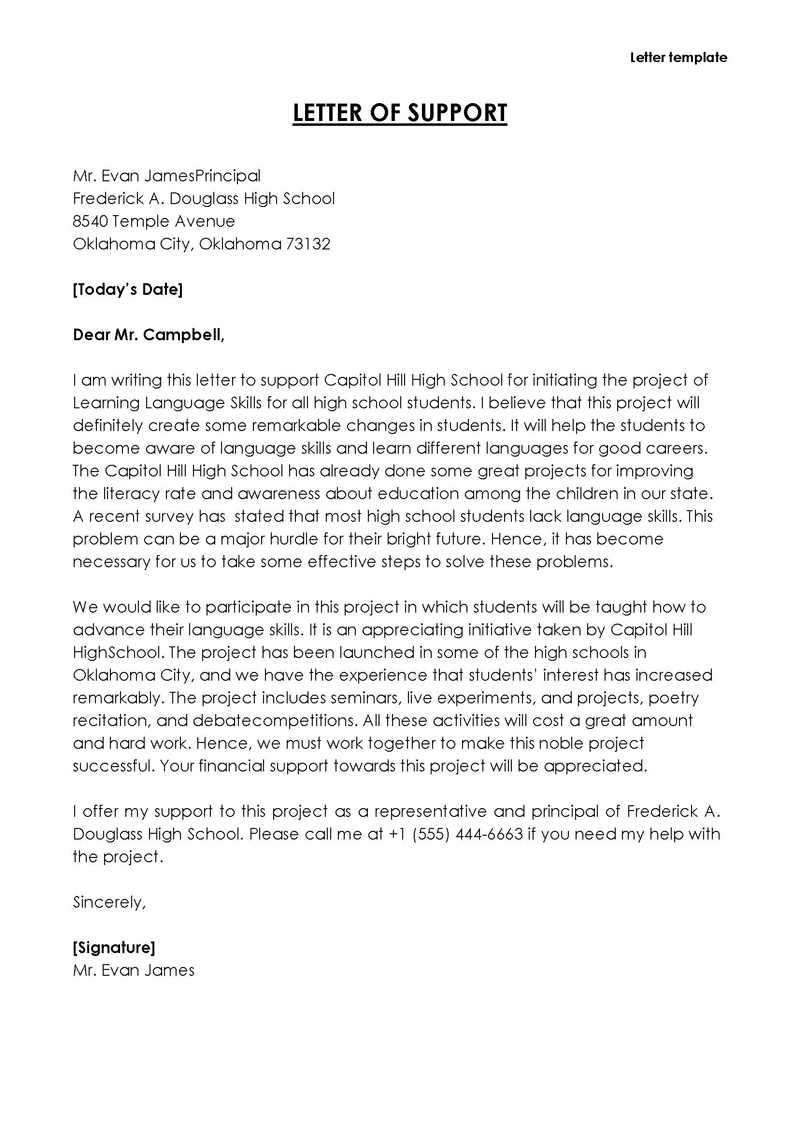
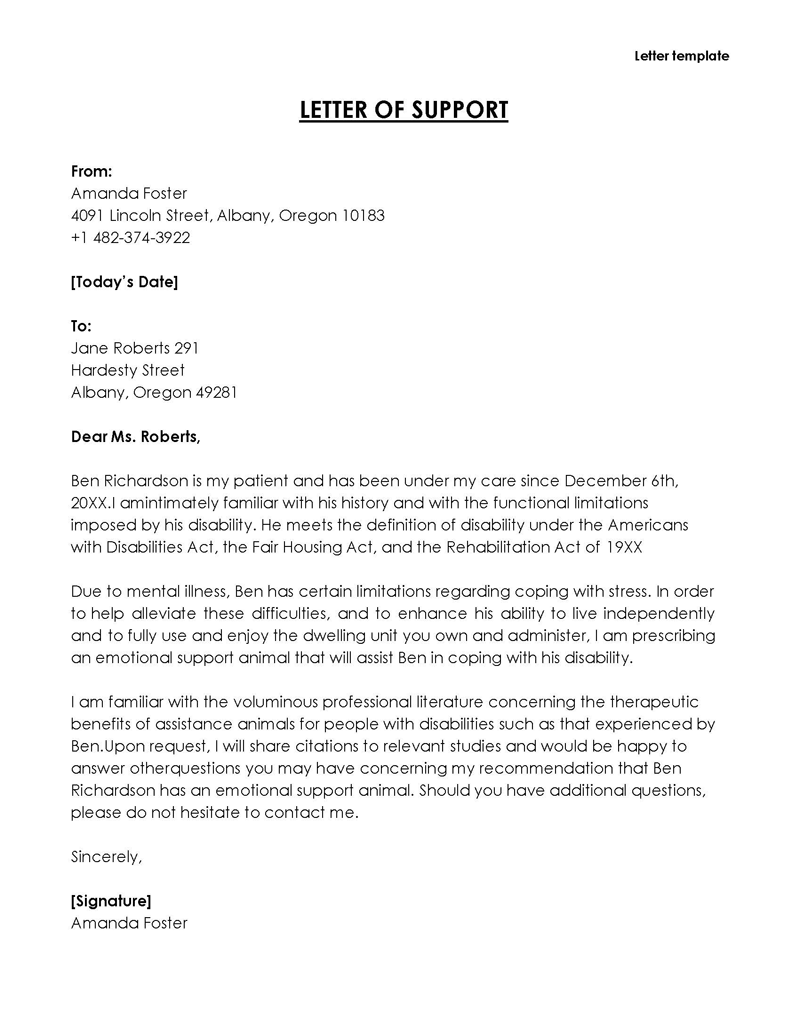
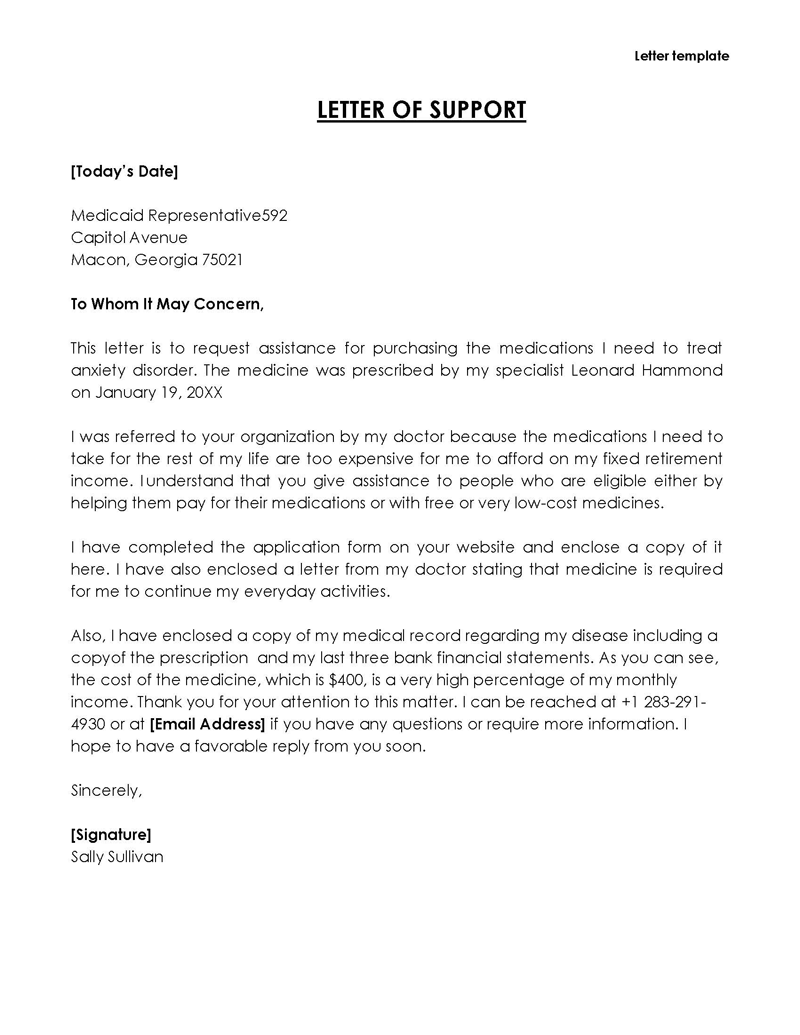
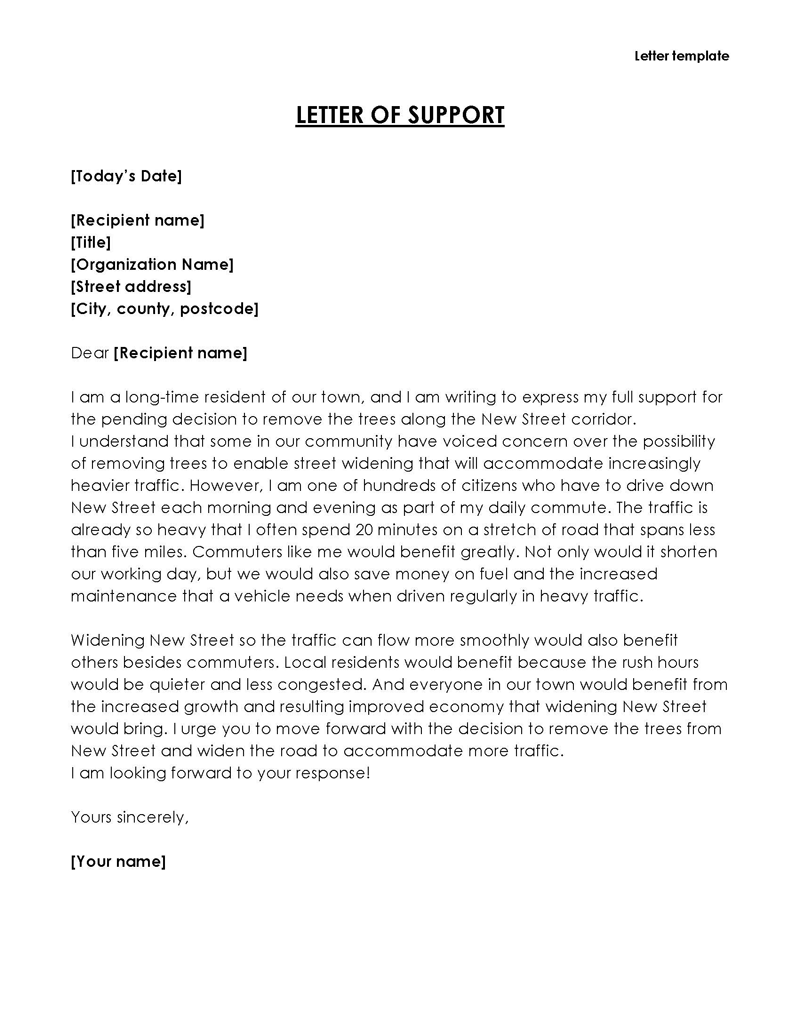
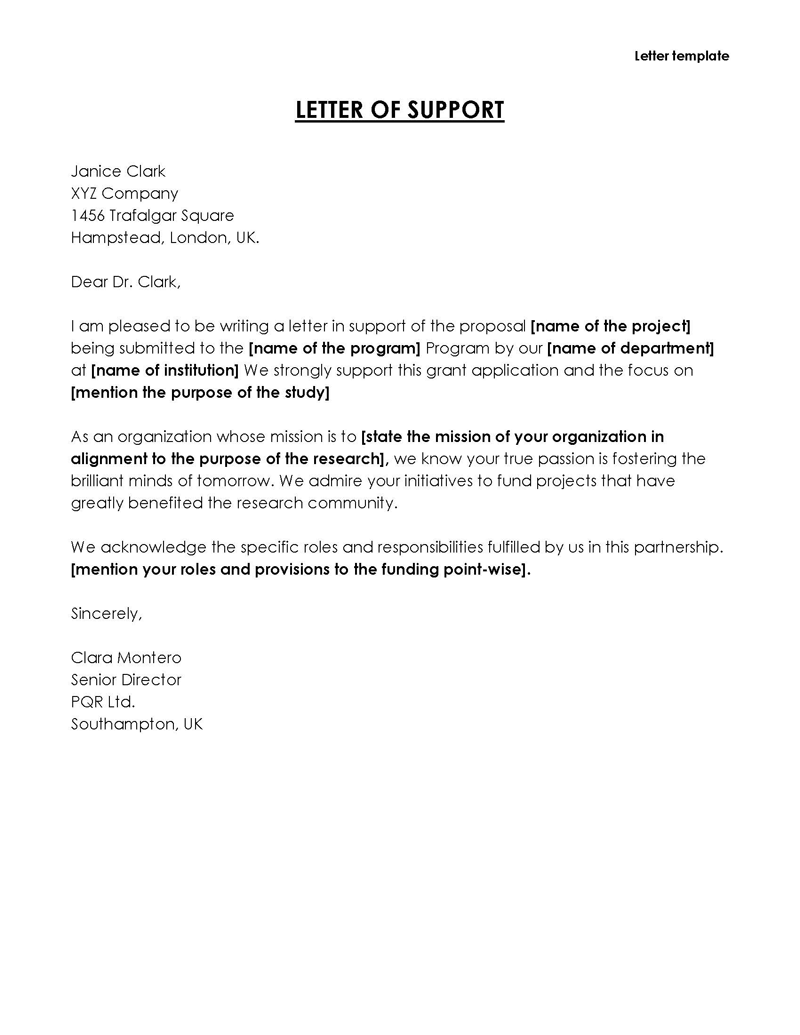
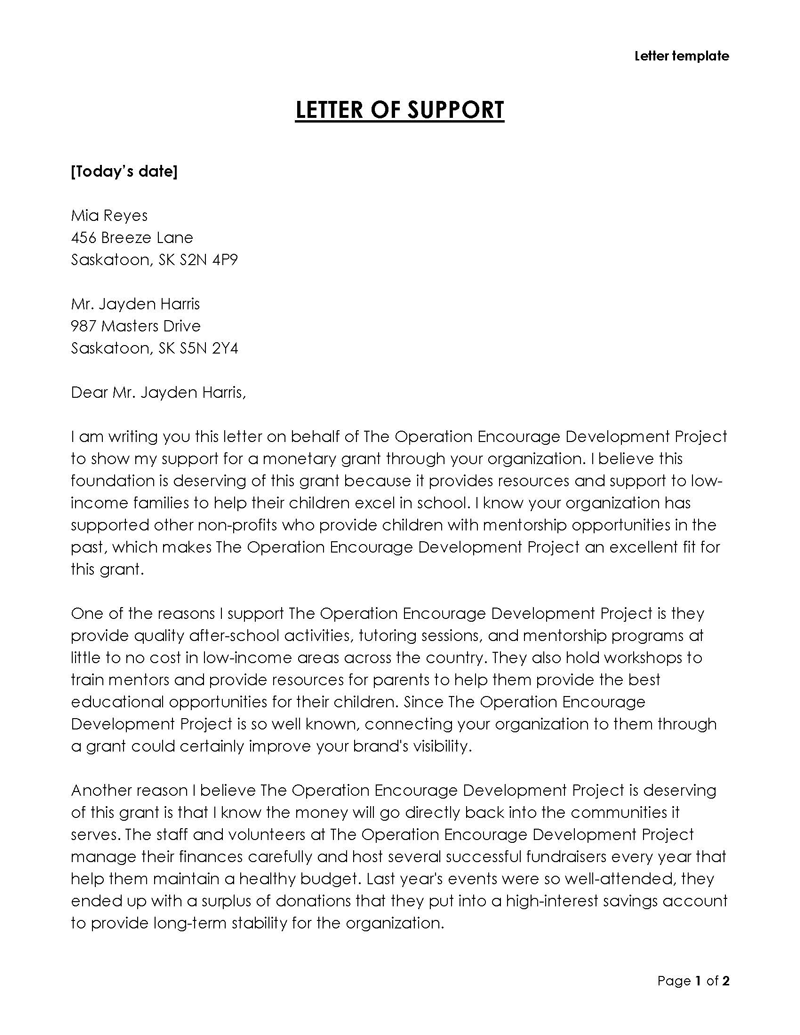
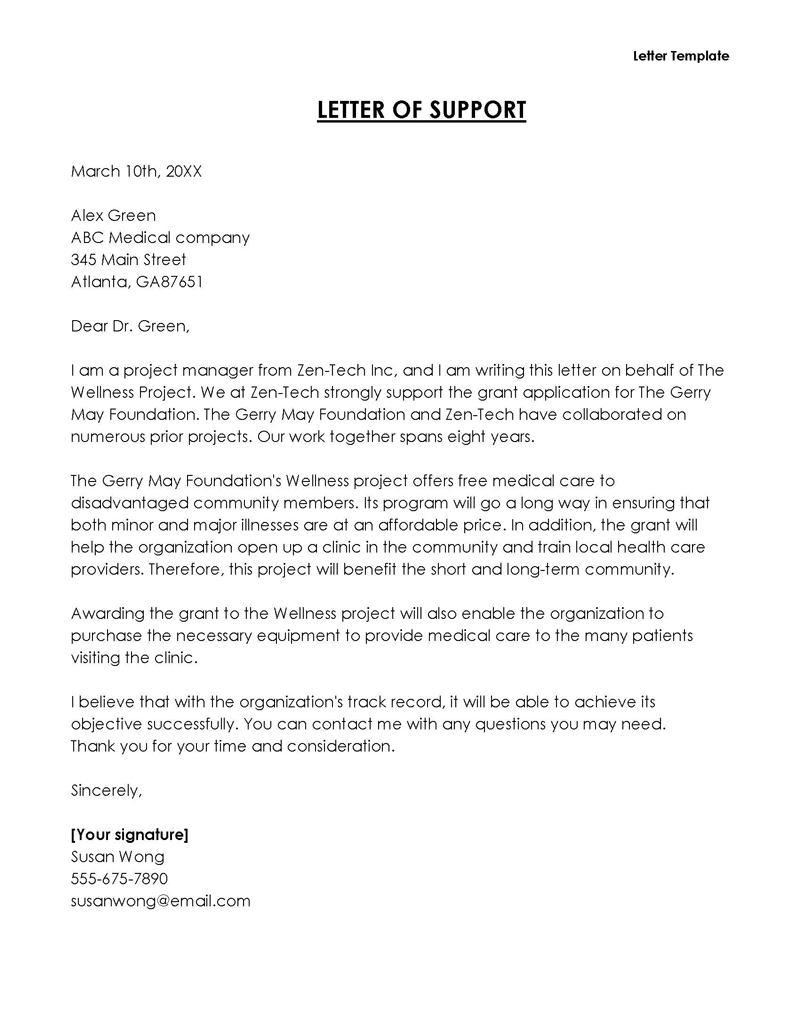
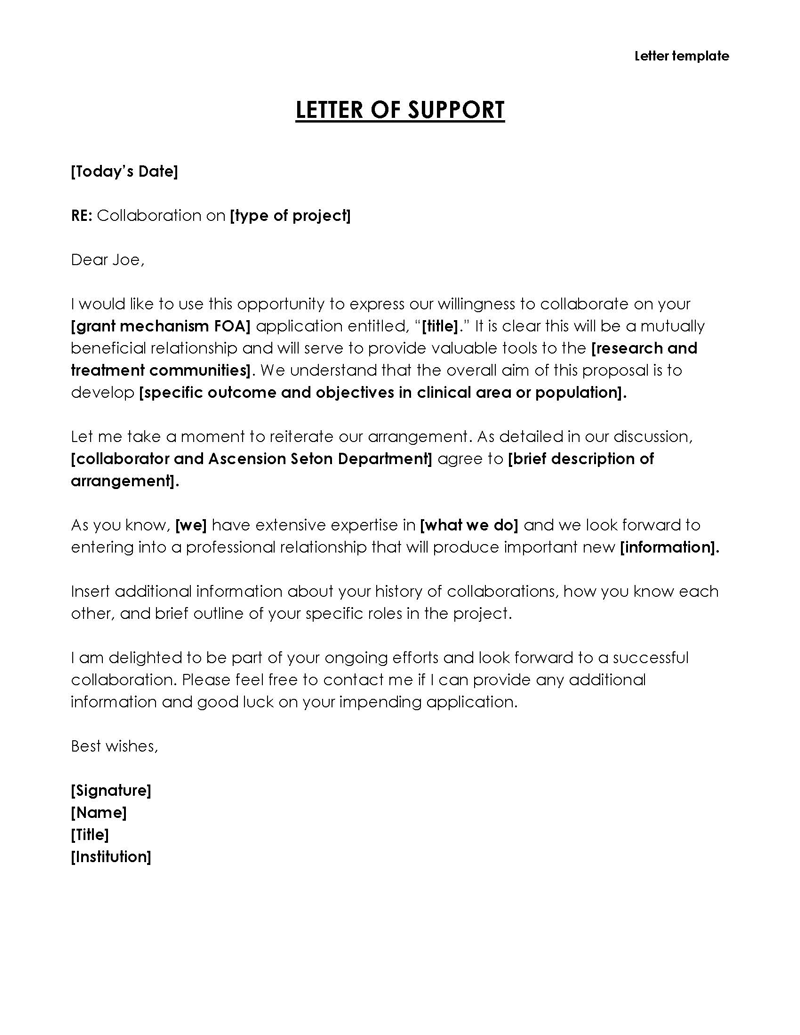
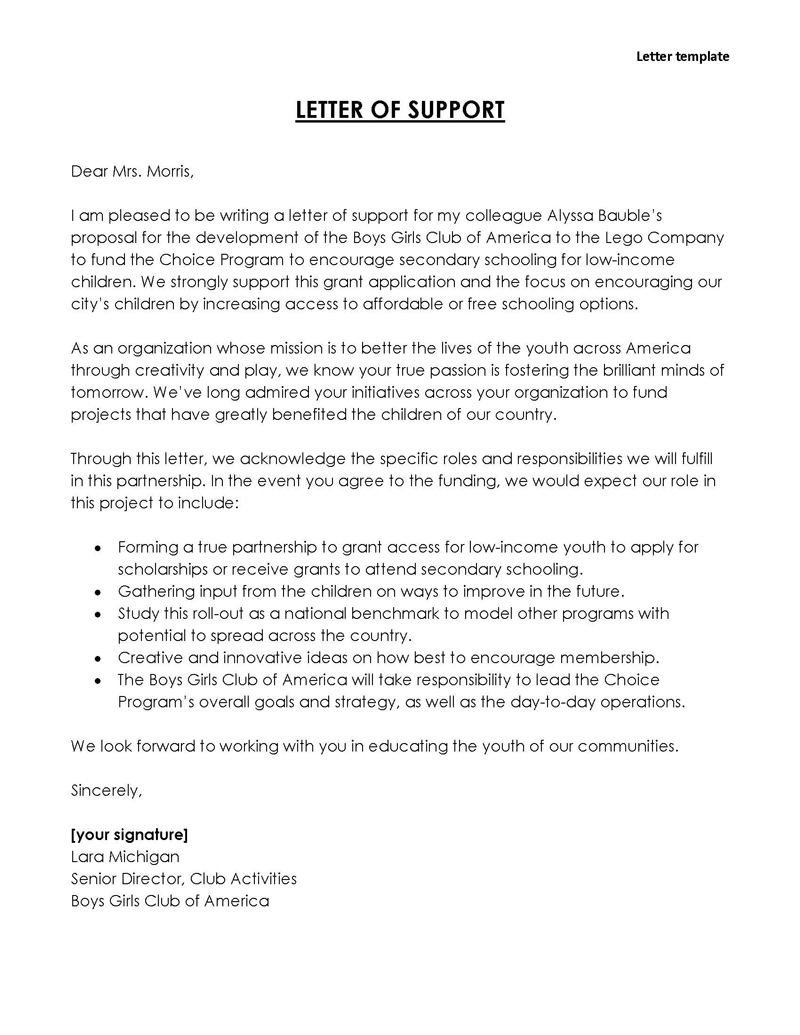
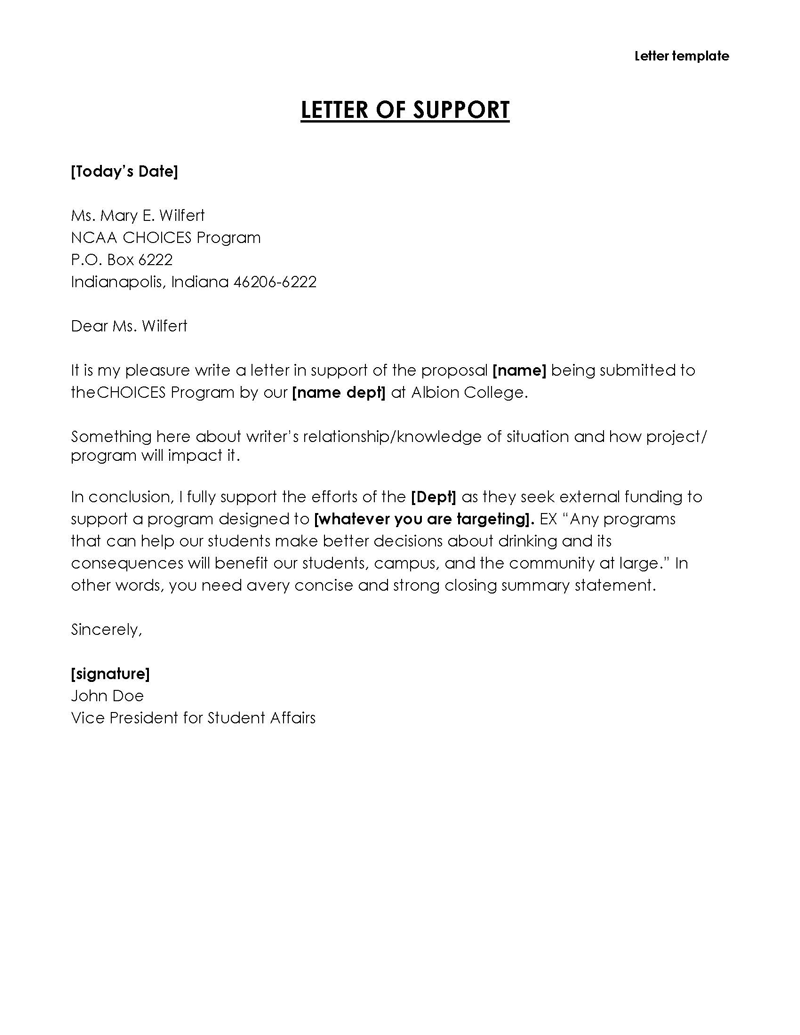
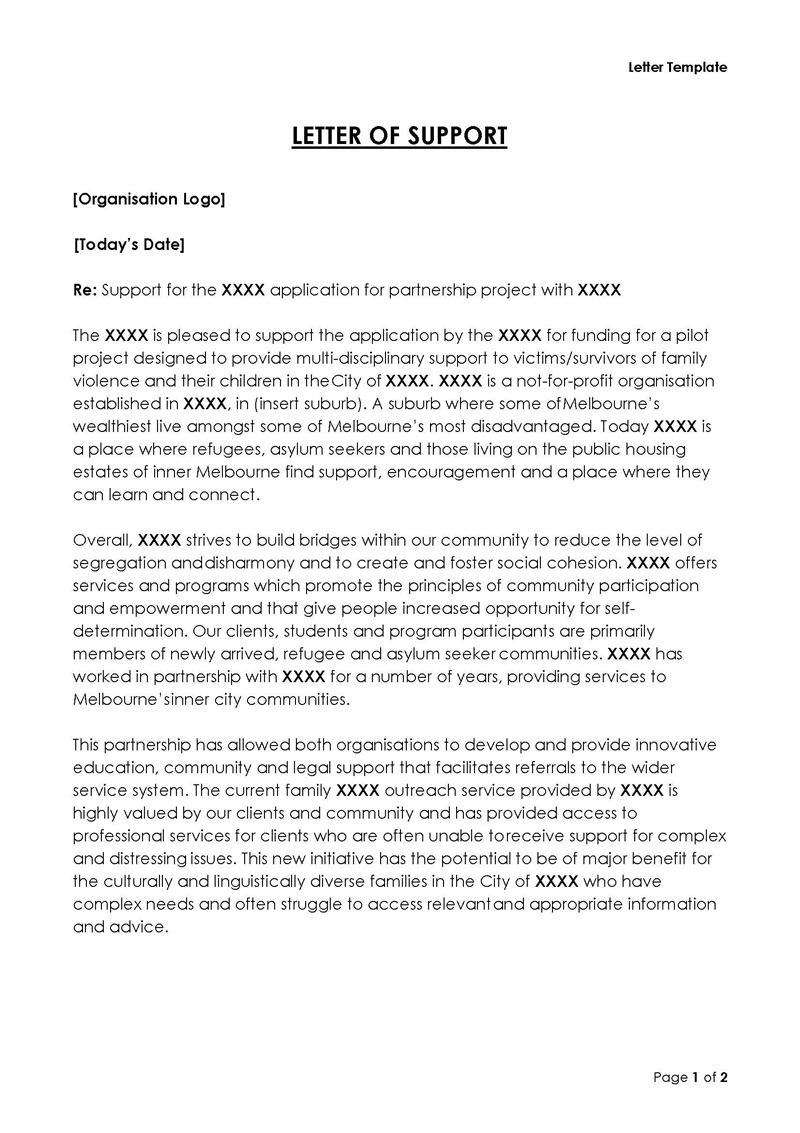
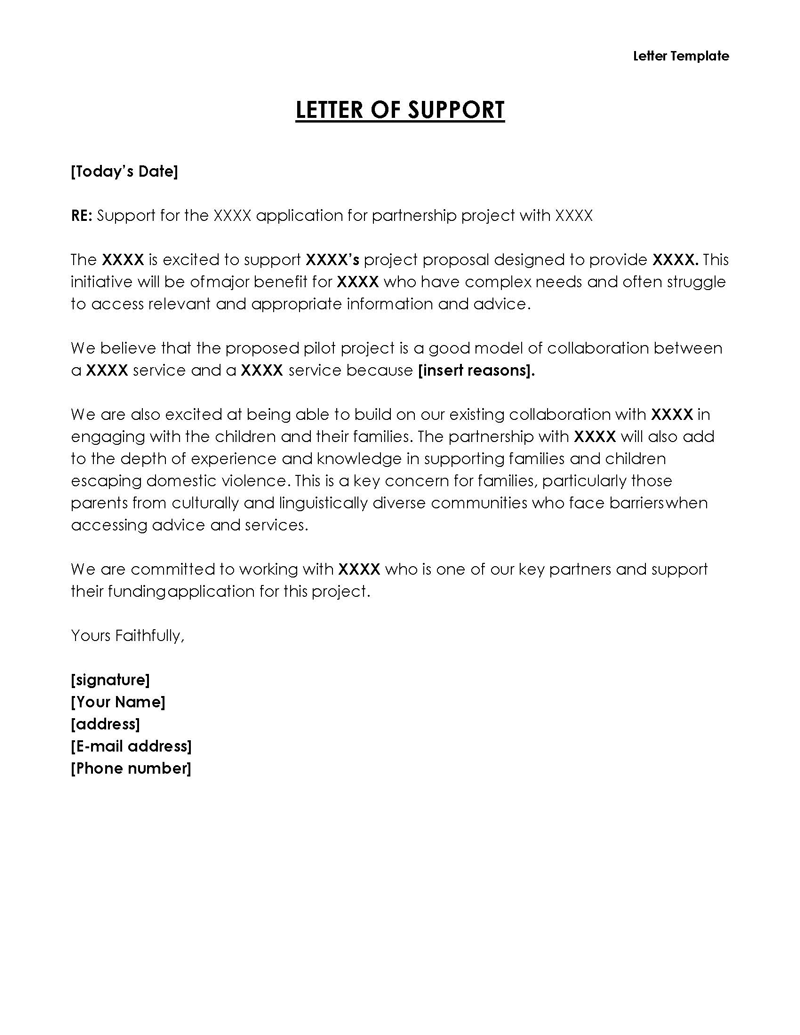
Tips for You
There are a few practices the writer should consider when writing a letter of support. These practices improve the quality of the letter. They will also help demonstrate the writer’s professionalism.
The practices include the following:
Consider your reader while writing
The writer should consider who is reading the letter. Considering who the reader is will help the writer tailor the information to them. The writer will also be able to incorporate information that the reader may have an interest in.
Follow the formatting guidelines
A font that is easy for the recipient to read, such as Calibri, Arial, Georgia, or Times New Roman, should be selected. A line spacing of 1.5 and a margin of 1 should be used to help space the paragraphs evenly. The letter also should be left-aligned. Lastly, the writer should ensure that the letter is only one page long.
Proofread the letter
Upon concluding the letter, the writer should proofread it to help identify and correct grammatical and spelling errors. It also helps the writer determine if the letter has adequate details. Another person can also proofread the letter on the writer’s behalf to identify mistakes.
Send the letter
Once the writer is satisfied with the letter, it should be sent to the grantor. The writer should also inform the nonprofit that the letter was sent to the recipient. The writer can either send the letter via email or certified mail.
Final Thoughts
A letter of support helps boost the nonprofit’s grant application or proposal. It is written by a third party outside the organization that has worked with it or benefits from its services. It shows that the nonprofit is qualified and capable of successfully implementing the project. The writer must clearly understand the application guidelines and the key points. The letter should contain information on a nonprofit’s mission or project and why it needs the funds. The writer can opt to use a template and review a letter of support sample to help ease the writing process. The writer must also ensure that proper formatting guidelines are adhered to to ease readability and give the letter a professional look.




